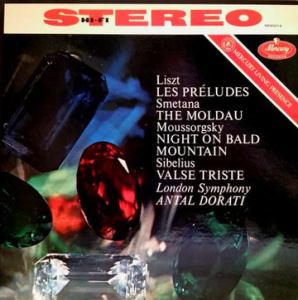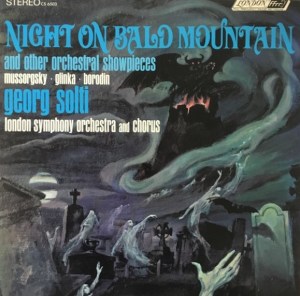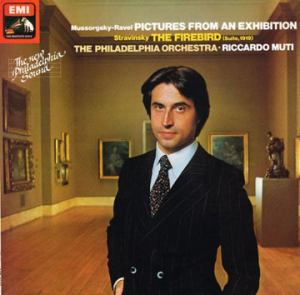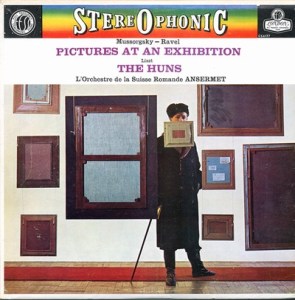
Hot Stamper LPs that Should Be Played on Big Speakers at Loud Levels
More Recordings that Sound Their Best on Big Speakers at Loud Levels
The darker brass instruments like tubas, trombones and french horns are superb here. Other Golden Age recordings of the work, as enjoyable as they may be in other respects, do not fully reproduce the weighty quality of the brass, probably because of compression, limiting, tube smear, or some combination of the three.
The brass on this record has a power like practically no other. It’s also tonally correct. It’s not aggressive. It’s not irritating. It’s just immediate and powerful the way the real thing is when you hear it live. That’s what really caught my ear when I first played the recording.
 There is a blast of brass at the end of Catacombs that is so big and real, it makes you forget you’re listening to a recording. You hear every brass instrument, full size, full weight. I still remember the night I was playing the album, good and loud of course, when that part of the work played through. It was truly startling in its power.
There is a blast of brass at the end of Catacombs that is so big and real, it makes you forget you’re listening to a recording. You hear every brass instrument, full size, full weight. I still remember the night I was playing the album, good and loud of course, when that part of the work played through. It was truly startling in its power.
Back then I had the Legacy Whisper speaker system, the one with eight 15″ woofers. They moved air like nobody’s business. If you want to reproduce the power of the trombone, the loudest instrument in the orchestra, they’re the speaker that can do it.
Some of Ansermet’s recordings with the Suisse Romande are absolutely the best I’ve ever heard. It was a magical combination of the right hall, the right engineers, the right orchestra and the right technology — the pure tube ANALOG technology of the ’50s and ’60s!
Dynamics
Another thing this recording has going for it is dynamic power. This is a dynamic piece of music. Few recordings I have ever heard have the dynamic contrasts that this one does. It really gets loud when it needs to. The best pressings sound completely uncompressed. Although I’m sure there has to be compression of one kind or another, the listener is rarely made aware of it.
Dynamics such as these are thrilling. They let the music come alive. Here at Better Records we are fans of big speakers and loud music and that combination is exactly what allows this record to be as powerful and moving as it is. We love that sound and have been proselytizing for equipment capable of recreating it in the home for more than 30 years.
How on earth is a speaker system like this one going to reproduce the power of all that brass?
The big finish with cymbal crashes and that amazing gong is worth the price of the album — when and if you can find one that’s not compressed and distorted from bad mastering or abuse. If you can find a more thrilling climax to a more powerful orchestral work, you must have one helluva classical collection. My hat’s off to you.
Powerful Bass
The third quality this record has is tremendous, powerful deep BASS. As you know, bass drum thwacks are called for throughout this composition. This is one of the few recordings where those bass notes don’t get “clipped” because the cutting amplifiers have run out of juice. That’s a sound that’s common to many Living Stereos. We put up with it because we like all the other qualities they have, but it’s a shortcoming of many of the tube cutting amplifiers from that era. The deep bass on this record is prodigious, as Dr. Strangelove might say. It really rocks the room.
If you prize Golden Age richness, lushness and Tubey Magic, this copy is going to be hard to beat. The hall is huge with tremendous depth and lovely reverberation. (Our Disney Hall here in L.A. does not have this kind of sound, I regret to say.)
 Production and Engineering
Production and Engineering
James Walker was the producer, Roy Wallace the engineer for these sessions from 1958 in Geneva’s glorious Victoria Hall. It’s yet another remarkable disc from the Golden Age of Vacuum Tube Recording.
The gorgeous hall the Suisse Romande recorded in was possibly the best recording venue of its day, perhaps of all time. More amazing sounding recordings were made there than in any other hall we know of. There is a solidity and richness to the sound that goes beyond all the other recordings we have played, yet clarity and transparency are not sacrificed in the least.
It’s as wide, deep and three-dimensional as any, which is of course all to the good, but what makes the sound of these recordings so special is the weight and power of the brass, combined with timbral accuracy of the instruments in every section.
Further Reading



 Hot Stamper Pressings of Living Stereo Titles Available Now
Hot Stamper Pressings of Living Stereo Titles Available Now Even twenty years ago reviewers noted that tracks on compilations such as this often had better sound than the albums from which they were taken, proof that they were listening critically and comparing pressings.
Even twenty years ago reviewers noted that tracks on compilations such as this often had better sound than the albums from which they were taken, proof that they were listening critically and comparing pressings.




 There is a blast of brass at the end of Catacombs that is so big and real, it makes you forget you’re listening to a recording. You hear every brass instrument, full size, full weight. I still remember the night I was playing the album, good and loud of course, when that part of the work played through. It was truly startling in its power.
There is a blast of brass at the end of Catacombs that is so big and real, it makes you forget you’re listening to a recording. You hear every brass instrument, full size, full weight. I still remember the night I was playing the album, good and loud of course, when that part of the work played through. It was truly startling in its power.  Production and Engineering
Production and Engineering